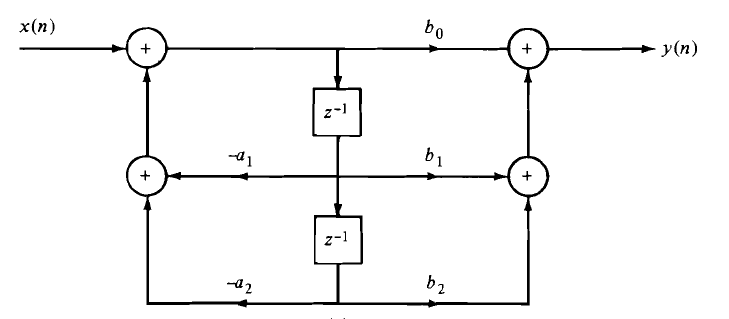This set of Digital Signal Processing Multiple Choice Questions & Answers (MCQs) focuses on “Implementation of Discrete Time Systems”.
1. The system described by the equation y(n)=ay(n-1)+b x(n) is a recursive system.
a) True
b) False
View Answer
Explanation: Since the present output depends on the value of the previous output, the system is called a Recursive system.
2. To implement the linear time invariant recursive system described by the difference equation y(n)=\(-\sum_{k=1}^N a_k y(n-k)+\sum_{k=0}^M b_k x(n-k)\) in Direct form-I, how many number of delay elements and multipliers are required respectively?
a) M+N+1, M+N
b) M+N-1, M+N
c) M+N, M+N+1
d) None of the mentioned
View Answer
Explanation: From the given equation, there are M+N delays, so it requires M+N number of delay elements and it has to perform M+N+1 multiplications, so it require that many number of multipliers.
3. Which of the following linear time invariant system is a purely recursive system?
a) y(n) = \(-\sum_{k=1}^{N} a_k y(n-k)+\sum_{k=0}^{M} b_k x(n-k)\)
b) y(n) = \(\sum_{k=1}^{N} a_k y(n-k)+\sum_{k=0}^{M} b_k x(n-k)\)
c) y(n) = \(-\sum_{k=1}^{N} a_k y(n-k)-\sum_{k=0}^{M} b_k x(n-k)\)
d) y(n) = \(-\sum_{k=1}^{N} a_k y(n-k)+b_0x(n)\)
View Answer
Explanation: Since the output of the system depend only on the past values of output and the present value of the input, the system is called as “purely recursive” system.
4. Which of the following is the difference equation of a special case of FIR system?
a) y(n) = \(\sum_{k=0}^{M} b_k x(n-k)\)
b) y(n) = \(a_0y(n)-\sum_{k=1}^{N} a_k y(n-k)\)
c) y(n) = \(-\sum_{k=1}^{N} a_k y(n-k)\)
d) None of the mentioned
View Answer
Explanation: If the coefficients of the past values of the output in the difference equation of the system, then the system is said to be FIR system.
5. What is the system does the following direct form structure represents?

a) FIR system
b) Purely recursive system
c) General second order system
d) None of the mentioned
View Answer
Explanation: Since the output of the system depends only on the present value of the input and the past values of the output, the system is a purely recursive system.
6. What is the output of the system represented by the following direct form?

a) y(n)=-a1y(n-1)-a2y(n-2)- b0x(n)-b1x(n-1)-b2x(n-2)
b) y(n)=-a1y(n-1)-a2y(n-2)+b0x(n)
c) y(n)=-a1y(n-1)-a2y(n-2)+ b0x(n)+b1x(n-1)+b2x(n-2)
d) y(n)=a1y(n-1)+a2y(n-2)+ b0x(n)+b1x(n-1)+b2x(n-2)
View Answer
Explanation: The equation of the difference equation of any system is defined as
y(n)=\(-\sum_{k=1}^Na_k y(n-k)+\sum_{k=0}^{M}b_k x(n-k)\)
In the given diagram, N=M=2
So, substitute the values of the N and M in the above equation.
We get, y(n)=-a1y(n-1)-a2y(n-2)+b0x(n)+b1x(n-1)+b2x(n-2)
7. The system represented by the following direct form structure is:

a) General second order system
b) Purely recursive system
c) Partial recursive system
d) FIR system
View Answer
Explanation: The output of the system according to the direct form given is
y(n)= b0x(n)+b1x(n-1)+b2x(n-2)
Since the output of the system is purely dependent on the present and past values of the input, the system is called as FIR system.
8. An FIR system is also called as “recursive system”.
a) True
b) False
View Answer
Explanation: For a system to be recursive, the output of the system must be dependent only on the past values of the output. For an FIR system the output of the system must be depending only on the present and past values of the input. So, FIR system is not an recursive system.
9. What is the form of the FIR system to compute the moving average of the signal x(n)?
a) y(n)=\(\frac{1}{M+1} \sum_{k=0}^M x(n-k)\)
b) y(n)=\(\frac{1}{M+1} \sum_{k=0}^M x(n+k)\)
c) y(n)=\(\frac{1}{M+1} \sum_{k=0}^{\infty} x(n-k)\)
d) None of the mentioned
View Answer
Explanation: A normal FIR non-recursive system with the impulse response h(n)=\(\frac{1}{M+1}\) is the system which is used to compute the moving average of a signal x(n).
10. Which of the following is a recursive form of a non-recursive system described by the equation y(n)=\(\frac{1}{M+1} \sum_{k=0}^Mx(n-k)\)?
a) y(n)=y(n-1)+\(\frac{1}{M+1}\)[x(n)+x(n-1-M)]
b) y(n)=y(n-1)+\(\frac{1}{M+1}\)[x(n)+x(n-1+M)]
c) y(n)=y(n-1)+\(\frac{1}{M+1}\)[x(n)-x(n-1+M)]
d) y(n)=y(n-1)+\(\frac{1}{M+1}\)[x(n)-x(n-1-M)]
View Answer
Explanation: The given system equation is y(n)=\(\frac{1}{M+1} \sum_{k=0}^M x(n-k)\)
It can be expressed as follows
\(y(n)=\frac{1}{M+1} \sum_{k=0}^M x(n-1-k)+\frac{1}{M+1}[x(n)-x(n-1-M)]\)
=\(y(n-1)+\frac{1}{M+1}[x(n)-x(n-1-M)]\)
11. The system described by the equation y(n)=ay(n+1)+b x(n) is a recursive system.
a) True
b) False
View Answer
Explanation: Since the present output depends on the value of the future output, the system is not called a Recursive system.
Sanfoundry Global Education & Learning Series – Digital Signal Processing.
To practice all areas of Digital Signal Processing, here is complete set of 1000+ Multiple Choice Questions and Answers.
If you find a mistake in question / option / answer, kindly take a screenshot and email to [email protected]
